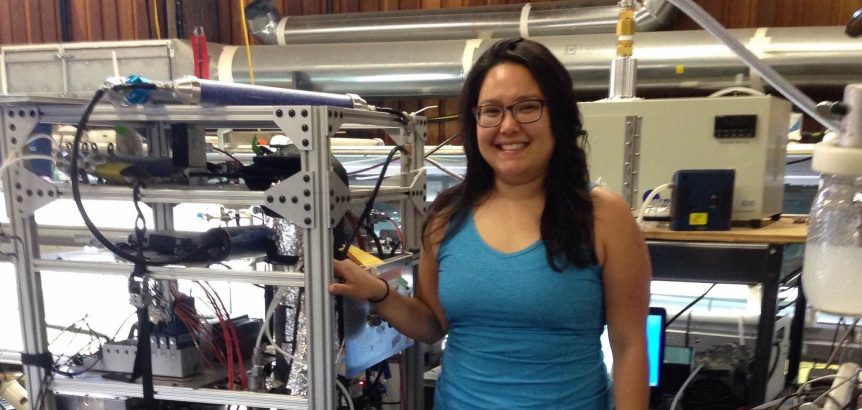Hello from the UCSD Hydraulics lab! The current time is 00:15, and I’m still a good 2 hours from my pillow. My task between now and zzz’s? Figure out how many ice nucleating particles are in the wave flume.
I am a fourth year graduate student in the Department of Atmospheric Science at Colorado State University. I work with Dr. Sonia Kreidenweis, Dr. Paul DeMott, Dr. Tom Hill and several others on ice nucleation. We are in La Jolla with IMPACTS because we want to know more about sea spray ice nucleating particles.
What is an ice nucleating particle (INP)?  Well, tiny pure water freezes at -40 C. But, we know that ice crystals exist in clouds at much warmer temperatures than -40C. This is because some (ice nucleating) particles serve as catalysts for ice crystal formation. I am here to operate the continuous flow diffusion chamber (CFDC), which counts the number of INP at a range of temperatures (-32C to -15C). We are also working with several other groups on collecting the INP for post analysis that will look at the chemical composition and shapes of the sea spray INP. We are hoping that by measuring INP through the duration of the phytoplankton bloom, we can observe links between sea spray INP (abundance, chemical and physical characteristics) and changes in the sea surface microlayer (see Josh’s post) and bulk water bacteria and phytoplankton counts.
Well, tiny pure water freezes at -40 C. But, we know that ice crystals exist in clouds at much warmer temperatures than -40C. This is because some (ice nucleating) particles serve as catalysts for ice crystal formation. I am here to operate the continuous flow diffusion chamber (CFDC), which counts the number of INP at a range of temperatures (-32C to -15C). We are also working with several other groups on collecting the INP for post analysis that will look at the chemical composition and shapes of the sea spray INP. We are hoping that by measuring INP through the duration of the phytoplankton bloom, we can observe links between sea spray INP (abundance, chemical and physical characteristics) and changes in the sea surface microlayer (see Josh’s post) and bulk water bacteria and phytoplankton counts.
A challenge of this measurement is INP exist in small numbers in the atmosphere. So, we use an aerosol concentrator, which enhances the number of particles that go into the CFDC and therefore we have a better chance of seeing an INP. It’s a very loud process, it’s like a giant vacuum, and takes all the flow from the system…. Hence the late night shift.
Some of us late nighters have started a saying when we leave the lab at 2 am… “Anotha day, anotha dot.” We do a lot of work everyday for what really may be just a “dot” on a graph showing a timeline or a correlation. But, with a month long study and enough dots, we are hopeful that all the dots will tell a story and lead to some interesting discoveries.
Christina McCluskey, PhD candidate, Department of Atmospheric Science, Colorado State University

